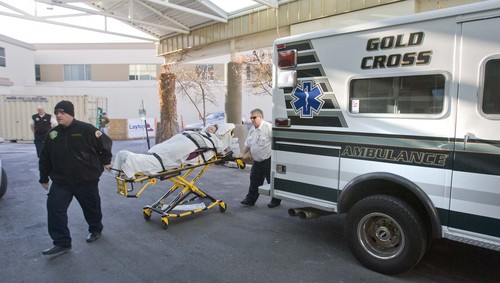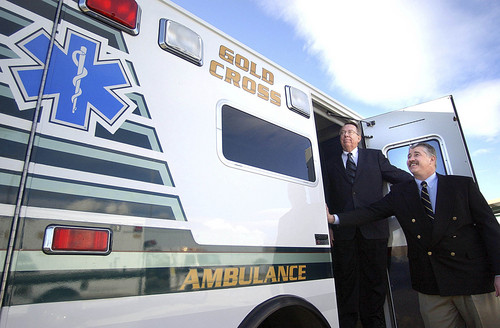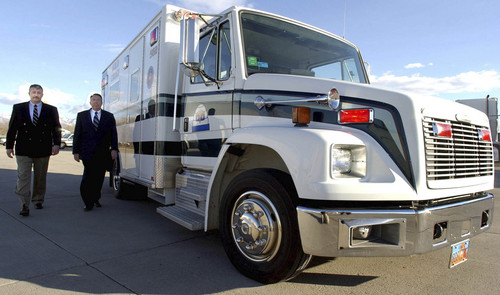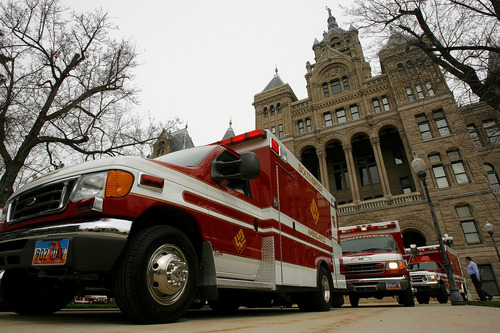This is an archived article that was published on sltrib.com in 2014, and information in the article may be outdated. It is provided only for personal research purposes and may not be reprinted.
Eighteen Utah doctors and six businesses drew down more than $1 million apiece in 2012 from Medicare, according to a detailed federal database of physician billings.
Statewide, about 160 providers received a total of $79.8 million in payments from the government program for the elderly that year. Utah health care businesses, such as laboratories and ambulance services, billed an additional $79.7 million.
That's a sliver of the $77 billion Medicare paid physicians and such services nationally in 2012. The data does not include hospital charges.
In releasing data that news outlets and consumer groups have sought for years, officials with the U.S. Centers for Medicare and Medicaid (CMS) say they hope to inform patients and spotlight inefficiencies and doctors who overcharge patients.
"Data transparency is a key aspect of transformation of the health care delivery system," said CMS Administrator Marilyn Tavenner in a press release.
But doctor lobbies fought the release, arguing the eye-popping payments are misleading, at best, or flat out wrong.
"I have no objection to this information being made public if they would have just placed it in context so people could interpret it correctly," said Vincent L. Hansen, a northern Utah oncologist. "It makes oncologists look like they're doing well, when in fact, there are very few independent oncologists. Most have merged with hospitals because the drugs they have to buy are extremely expensive and it's hard to get payors to cover the costs."
Hansen and his partner, oncologist Carl R. Gray, billed $3.8 million and $4.5 million to Medicare, respectively.
They are Utah's top billers, according to an interactive map of the Medicare data by the Wall Street Journal, which is searchable by state, city, specialty and physician names.
Behind them are three ophthalmologists with Rocky Mountain Retinal Consultants: Mitchell J. Goff, Peter R. Miller-Hurlbut and David W. Faber, who each received more than $2 million. Also in the million-dollar club are a neurologist and a rheumatologist.
All of these providers either have a lock on the local market or they're widely recognized experts in a specialized field.
Most importantly, embedded in their Medicare payments is their overhead, namely the cost of expensive drugs that must be given to patients under a doctor's supervision — chemotherapy agents and other intravenous treatments. This means the lion's share of their Medicare payments flow not to them, but to big pharma.
About $148,000 of oncologist Carl Gray's Medicare payments in 2012 were for office visits; the rest was for chemo infusions.
"We have to buy those drugs in advance and bill Medicare later," said David Pittam, office manager for Gray and Hansen. "Medicare negotiates the prices. We have no control over that, no negotiating room at all."
Because hospital-employed oncologists and ophthalmologists bill Medicare only for their services, they don't show up among the top billers –– when, in reality, they might be.
Their drug costs are covered by their employer and hospital charges aren't included in this Medicare data set.
The three doctors at Pittam's Ogden-based Utah Hematology Oncology do brisk business.
"We don't have a lot of competition up here," Pittam said. "We treat a lot of patients and Medicare represents about half of our business. But that's true for hospitals, too, and if we sent all our patients to a hospital for chemo it would cost the system more, because there's an additional component of reimbursement that hospitals get that we don't get."
The way Medicare reimburses doctors, however, can give them a financial incentive to use pricier drugs. Medicare pay doctors the "average sales price" for a drug, plus 6 percent.
About $2 million of Salt Lake City ophthalmologist Mitchell Goff's $2.6 million in payments was for 6,132 Lucentis injections, a drug used for macular degeneration.
Sometimes Goff used a cheaper alternative, Avastin. Had he used it exclusively, his Medicare payments would have dropped to about $890,000.
While some physicians see the drugs as equivalent, others say Avastin is less safe. The cancer drug has not been approved by the Food and Drug Administration (FDA) for use in treating macular degeneration.
Most Utah eye doctors, including Goff's partners at Rocky Mountain Retinal Consultants, favor Lucentis, Medicare data show.
Rocky Mountain administrator Kari Rasmussen said such decisions are based on years of FDA-approved research and clinical experience.
"Our physicians are motivated by what is in the best interest of our patients," she said in an emailed response to questions. "We do not receive incentives from pharma to use their drugs."
In reality, doctors don't always get the 6 percent markup, she added. Avastin generally has a "considerably" higher margin than Lucentis, she added.
Though expensive, Rasmussen said, today's drugs are "able to stave off debilitating vision loss," giving patients a higher quality of life and prolonged independence. "This also relieves the burden on their families, care givers, and the community at large," she said.
Rocky Mountain retina doctors draw patients from across Utah, Nevada, Montana and Wyoming.
"Our practice is very busy and the doctors work long hours," Rasmussen said, noting Medicare accounts for 75 to 80 percent of the practice's revenue.
Others question the accuracy of the Medicare data.
The records say Salt Lake City neurologist John Foley performed 155,000 IV "natalizumab" injections for multiple sclerosis patients.
"But we didn't perform that many injections. The 155,000 number reflects grams per infusion, and there might be 300 grams per injection," said Foley's office manager, Robert Allred.
Foley ranks high, Allred said, because "he's one of the top MS docs in the western United States. We have people coming to him from outside Utah for treatment."
Tribune reporter Kristen Moulton contributed to this story.
—
Where Medicare's money goes in Utah
In Utah, ophthalmologists and oncologists receive the highest total Medicare payments, because those payments include the costs of expensive drugs they administer to patients.
$19.9 million, ophthalmology
$14.6 million, hematology/oncology
$14.3 million, miscellaneous*
$6.3 million, cardiology
$5.9 million, dermatology
$5.2 million, rheumatology
$3.8 million, radiation oncology
$3.2 million, internal medicine
$2.7 million, orthopedic surgery
$2.5 million, neurology
$1.4 million, nephrology
* Miscellaneous includes, anesthesiology, diagnostic radiology, family practice doctors and others.
Source: U.S. Centers for Medicare and Medicaid; analysis by The Salt Lake Tribune —
Find your doctor
To search Medicare's 2012 billings by state, city, specialty and physician names, visit an interactive graphic at the Wall Street Journal. —
Utah's top Medicare billings
Eighteen Utah physicians and six businesses billed Medicare for $1 million or more in 2012, according to billing data released by the U.S. Centers for Medicare and Medicaid.
Hematology/oncology
$4.5 million, Carl R. Gray
$3.8 million, Vincent Hansen
$1.8 million, Joseph D. Te
$1.3 million, Jay C. Bott
$1.1 million, Steven L. Wallentine
$1.1 million, Wendy A. Breyer
Ophthalmology
$2.6 million, Mitchell J. Goff
$2.3 million, Peter R. Hurlbut-Miller
$2.2 million, David W. Faber
$2.1 million, Kirk E. Windward
$2.1 million, Robert C. Kwun
$1.5 million, Douglas S. Mehr
$1.3 million, John A. Carver
$1.2 million, Mano Swartz
$1.1 million, Sharon R. Richens
$1.1 million, James G. Howard
Rheumatology
$1.6 million, Jeffrey L. Matthews
Neurology
$1.1 million, John F. Foley
Laboratories
$54 million, Myriad Genetic Laboratories, Inc.
$2.3 million, Intermountain Health Services, Inc.
Ambulance service supplier
$2.6 million, Classic Air Care, Inc.
$2.6 million, Gold Cross Services, Inc.
Ambulatory surgical centers
$1.6 million, Central Utah Surgical Center, LLC
$1.3 million, Coral Desert Surgery Center
Sources: Wall Street Journal, U.S. Centers for Medicare and Medicaid









